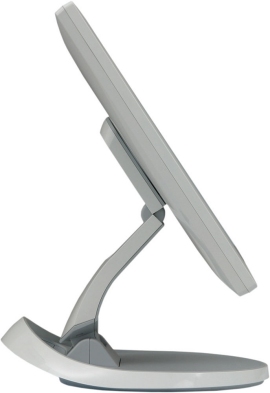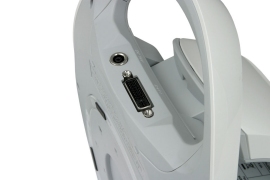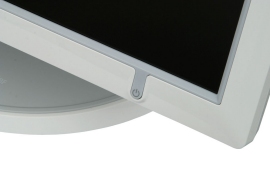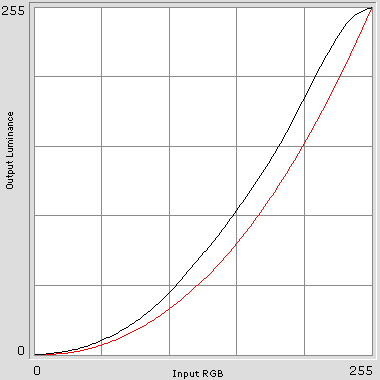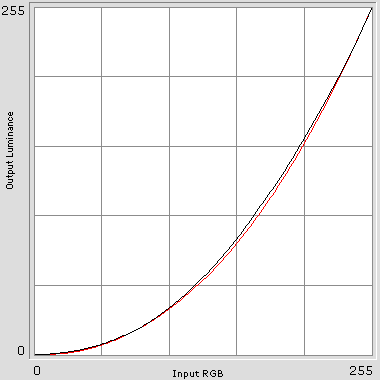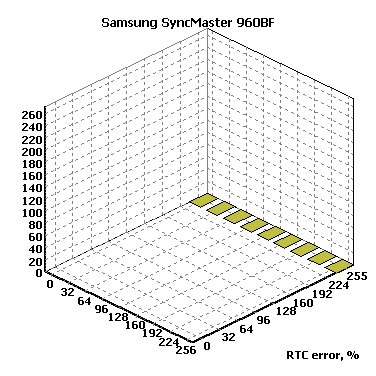LCD MONITOR REVIEW SAMSUNG SYNCMASTER 960BF 19 INCH
![]()
|
|
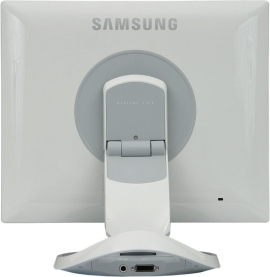 |
||||||||||||
| Posted:2006-07-08 By lcd monitor Number of View:30819 |
|||||||||||||
By :lcd monitor Posted:2006-07-08
Samsung SyncMaster 960BF
I tested the 17” version of this lcd lcd monitor in our article dedicated to Response Time Compensation technology. Though having a bigger model number than the 940BF, the 960BF model was released earlier and has a specified response time of 4 milliseconds, i.e. 2 milliseconds higher than that of the 940BF.
The SyncMaster 960BF looks just splendid. It has a milk-white case with rounded angles and decorative light-gray inserts with a bit of a lilac hue. The stand is round with a kind of a handle at the back. This lcd lcd monitor looks attractive due to its all-around harmony and gracefulness of design rather than to contrasting colors or shiny surfaces. Although the plastic of the case is glossy, it doesn’t produce too many flares. Reflections on this plastic are not as irritating and distracting as on the popular glossy black plastic. Moreover, fingerprints and dust which is too visible on black plastic is almost invisible here. And of course this design raises associations with products from Apple – a white glossy plastic is a very traditional solution for this company.
The lcd lcd monitor is equipped with Samsung’s dual-hinge stand that allows adjusting the tilt and height of the screen. The height can be varied in a small range (compared with classic vertical stands), but the fact is many users want to lower the screen rather than to lift it up because the laws of ergonomics recommend positioning the screen in such a way that its top is at your eyes level or a little lower. And from this point of view, the stand of the 960BF is superb: you can almost lay the screen on the desk and, unlike with the above-described EIZO FlexScan L778, you can place it vertically or push the top a little backwards. Unlike other Samsung lcd lcd monitors with similar stands, this lcd lcd monitor is folded forward rather than backward for transportation. The portrait mode is available here.
The lcd lcd monitor has analog and digital inputs, but only one DVI-I connector. DVI-DVI and DVI-D-Sub cables are included in the box. They must have resorted to this solution due to the lack of space for connectors at the back of the base, under the “handle”. A connector for the external power adapter is located there, too.
The single button this lcd lcd monitor offers is Power. But unlike Apple who’s abandoning all settings (besides brightness) in its lcd lcd monitors, Samsung prefers full-featured control over the lcd lcd monitor, but via software from the computer the lcd lcd monitor is connected to. Windows and MacOS users can install the MagicTune program ., but further improved and supported by Samsung); Linux users should take a look at the DDCcontrol project and users of other OSes at other lcd lcd monitors. The lcd lcd monitor has 80% brightness and 50% contrast by default. To have 100-nit brightness of white, I dropped the brightness and contrast settings to 30% and 33%, respectively. After that you can close MagicTune altogether because the lcd lcd monitor remembers the values you specify.
The lcd lcd monitor has too much of contrast at its default settings: all the three gamma curves have that characteristic bend in their top right. Well, everything returns back to norm as soon as you reduce the contrast setting.
Here, the gamma curves look well and I have nothing to complain about. And my advice to you is to keep the lcd lcd monitor’s contrast setting below 40-45% to have a more accurate reproduction of colors.
The color temperature setup is better than average, yet the difference between the temperatures of white and gray may be as big as 1000K. Still, this is a rather good result for a games-oriented home lcd lcd monitor, which is not meant for serious work.
The average response time of this lcd lcd monitor is 5.4 milliseconds, which is almost two times the response time of the SyncMaster 940BF, but much better than the speed of RTC-less models. The 960BF takes the longest time to perform transitions between light tones which may be as slow as 15-20 milliseconds.
The RTC error measurements produce an ambiguous picture. On one hand, the averaged error of 17% is a little lower than the 940BF’s. But on the other hand, the error amounts to 270% on black to dark-gray transitions, i.e. where it is the most conspicuous. You can imagine what you’re going to see on the screen of this lcd lcd monitor in dynamic games with dark textures! And the average error itself, even though smaller than the 940BF’s, is higher than the competitors’. For example, the BenQ FP93GX has an average RTC error of 15.2% in my tests and is faster than the 960BF, too.
The lcd lcd monitor’s contrast ratio is excellent, which is in fact typical of Samsung’s matrixes, even if they are TN+Film. So, the SyncMaster 960BF is a cute-looking, handy and generally well set-up lcd lcd monitor. It is a nice diversion from both uniform-looking office models and fanciful home lcd lcd monitors. The downside is Samsung’s persisting problems with implementing RTC in TN+Film matrixes (it’s all right with PVA matrixes as you’ve seen earlier) – the average RTC error on Samsung’s lcd lcd monitors is considerably higher than on competitors’. And while the excellent speed of the 940BF’s matrix is a kind of compensation for that, the 960BF is not that fast, but has a rather big average error.
we would be happy to answer for your question . if you have suggestion or comment
regarding this review our support would be glad to help just join our forum and ask u will get the best answer
to discuss check our forum section :-) RATE THIS REVIEW | |||||||||||||
![]()

lcd monitor review Samsung SyncMaster 960BF 19 inch
lcd monitor review Samsung SyncMaster 960BF 19 inch


7600gt review
7600gt is the middle card range.
We already benchmarked this video card and found that ...

 geforce 8800gtx and 8800gts
geforce 8800gtx and 8800gts  Xtreview software download Section
Xtreview software download Section  AMD TURION 64 X2 REVIEW
AMD TURION 64 X2 REVIEW  INTEL PENTIUM D 920 , INTEL PENTIUM D 930
INTEL PENTIUM D 920 , INTEL PENTIUM D 930  6800XT REVIEW
6800XT REVIEW  computer hardware REVIEW
computer hardware REVIEW  INTEL CONROE CORE DUO 2 REVIEW VS AMD AM2
INTEL CONROE CORE DUO 2 REVIEW VS AMD AM2  INTEL PENTIUM D 805 INTEL D805
INTEL PENTIUM D 805 INTEL D805  Free desktop wallpaper
Free desktop wallpaper  online fighting game
online fighting game  Xtreview price comparison center
Xtreview price comparison center 

- The new version of GPU-Z finally kills the belief in the miracle of Vega transformation
- The motherboard manufacturer confirms the characteristics of the processors Coffee Lake
- We are looking for copper coolers on NVIDIA Volta computing accelerators
- Unofficially about Intels plans to release 300-series chipset
- The Japanese representation of AMD offered monetary compensation to the first buyers of Ryzen Threadripper
- This year will not be released more than 45 million motherboards
- TSMC denies the presentation of charges from the antimonopoly authorities
- Radeon RX Vega 64 at frequencies 1802-1000 MHz updated the record GPUPI 1B
- AMD itself would like to believe that mobile processors Ryzen have already been released
- AMD Vega 20 will find application in accelerating computations
- Pre-orders for new iPhone start next week
- Radeon RX Vega 57, 58 and 59: the wonders of transformation
- ASML starts commercial delivery of EUV-scanners
- The older Skylake processors with a free multiplier are removed from production
- Meizu will release Android-smartphone based on Helio P40
- AMD Bristol Ridge processors are also available in American retail
- The fate of Toshiba Memory can be solved to the next environment
- duo GeForce GTX 1080 Ti in GPUPI 1B at frequencies of 2480-10320 MHz
- New Kentsfield overclocking record up to 5204 MHz
- Lenovo released Android-smartphone K8



computer news computer parts review Old Forum Downloads New Forum Login Join Articles terms Hardware blog Sitemap Get Freebies


